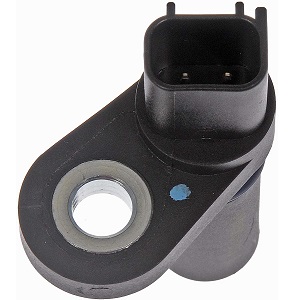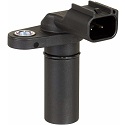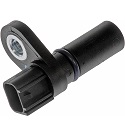
Function Of A Camshaft Position Sensor
Camshaft position sensors are used to index the position of the camshaft(s) relative to a fixed reference point, telling the vehicle’s ECU (Engine Control Unit) where the camshaft is positioned from a rotational standpoint. The ECU uses this input data from the camshaft position sensor to calculate appropriate fuel delivery strategies, in the sense that the position of the camshaft(s) determines when to activate each fuel injector.
On engines with two camshafts per bank of cylinders (i.e., an intake and an exhaust camshaft), each camshaft is usually fitted with its own dedicated camshaft position sensor. For these engines, the ECU uses the input data from the two sensors to ensure that the camshafts are synchronized with fuel delivery appropriately.
In addition, on engines that are fitted with variable valve timing (such as Honda’s VTEC or BMW’s VANOS), the ECU has the ability to rotate each camshaft independently based in part on camshaft position sensor data in order to alter the valve timing. Doing this has the advantage of increasing power at higher engine speeds without sacrificing fuel economy at lower speeds.
Common Symptoms Of A Faulty Camshaft Position Sensor
Although the nature and severity of the symptoms of failed or failing camshaft position sensors can vary vehicle to vehicle, the most common symptoms are listed below:
Engine Won’t Start
Since camshaft position sensors largely control the sequence of fuel injection events, a failed camshaft position can affect fuel delivery to the engine by “confusing” the ECU, preventing the vehicle from starting.
Engine Misfires
Inaccurate input data regarding the position of one or more camshafts can cause the ECU to inject fuel at the wrong time, which causes severe misfires that can even damage catalytic converters due to a rich running condition if not repaired in a timely fashion.
Rough Or Hunting Idle
This is especially common on engines with variable valve/camshaft timing. Even if the valve timing actuators return the camshafts to their proper positions during idling or low engine speeds, incorrect input data from a failing camshaft position sensor could cause the ECU to “think” that the camshaft timing is more or less advanced than it actually is. Since this condition has a direct bearing on fuel injection and ignition timing settings, the idling quality can suffer greatly.
Power Loss
Depending on both the nature of the failure and the vehicle, power loss and increased fuel consumption can result from defective camshaft position sensors since the ECU can dump excessive fuel based on faulty camshaft position sensor data.
Replacing Camshaft Position Sensors
Camshaft position sensors are almost invariably easy to access, and although it is sometimes necessary to remove cosmetic engine shields and covers, the actual replacement procedure is a relatively straightforward affair that most DIY mechanics should be able to handle.
Note: The example steps below are intended for general informational purposes solely to help give you an idea of project difficulty and tools required. As all cars are engineered differently, repair procedures and safety hazards vary from vehicle to vehicle. To ensure that you have a vehicle specific repair procedure and an exhaustive list of potential safety hazards, we advise you reference a factory service manual for your vehicle. Similarly, referencing a repair manual such as Chilton or Haynes might serve as a less expensive alternative.
Step 1 – Make sure the engine is cold to prevent burns and scalds. If required, remove all cosmetic engine shields/covers, and place them safely out of the way. Sometimes you may benefit from a set of small screwdrivers to remove engine cover fasteners. A magnetic tray may also make keeping track of your fasteners easier.
Step 2 – Identify the camshaft position sensor(s). These are usually located on the valve covers or adjacent to them and are usually held in place with only one or two fasteners. Rarely, replacing cam position sensors requires the removal of the valve cover for access. If you need to remove the valve cover, this would be a great time to replace your valve cover gasket since they are relatively inexpensive, are leak prone, and you have already done most of the work. If this is the case, you may also find a gasket scraper helpful.
Step 3 – Disconnect the sensor’s electrical connectors, remove the fasteners that mount the sensor with a ratchet (you may need to opt for a box wrench for easier access), and remove the sensor.
Step 4 – Install the new camshaft position sensor, but be sure to replace the oil seal (usually an O-ring) as well to prevent future oil leaks. Insert and tighten the retaining fastener, reconnect the electrical connector, and make sure all wiring is secured properly.
Step 5 – If you have multiple camshaft position sensors, it may make sense to replace them all as a preventative measure. Usually all of the cam position sensors in a vehicle are the same part number, meaning if one reaches the end of its service life, the others often follow shortly thereafter. Once all the camshaft sensors are replaced, reinstall all engine shields and covers (including the valve cover with a new gasket if you needed to remove it) in the reverse order of removal, and start the engine to verify the repair once you are sure everything has been assembled properly.
Best Camshaft Position Sensor Brands
When it comes to finding a camshaft position sensor replacement for your vehicle, there are tons of brands out there. As such, it can be hard to choose the best ones. In attempt to save you some time, we have highlighted our favorites in hopes that it makes finding the best camshaft position sensor brand for your vehicle as easy as possible for you.
Spectra
 Camshaft position sensors made and supplied by Spectra are known to meet and/or exceed OEM standards in terms of fit, function, and performance. Sensors made by Spectra are subject to stringent quality testing that includes thermal shock, which ensures reliable performance even under extreme operating conditions. Overall, Spectra’s build quality is great and we expect that their camshaft sensors will last for the long haul should you decide to use them for your next project.
Camshaft position sensors made and supplied by Spectra are known to meet and/or exceed OEM standards in terms of fit, function, and performance. Sensors made by Spectra are subject to stringent quality testing that includes thermal shock, which ensures reliable performance even under extreme operating conditions. Overall, Spectra’s build quality is great and we expect that their camshaft sensors will last for the long haul should you decide to use them for your next project.
Click here to find a Spectra camshaft position sensor for your vehicle.
Dorman
 Camshaft position sensors made and supplied by Dorman are designed to be direct-fit replacements for OEM equipment. Dorman makes a variety of high quality automotive components, including a variety of sensors. Their products meet and often exceed OEM performance and reliability standards, which is supported by a limited lifetime warranty on many of their products. Overall, we think you’ll be satisfied if you choose Dorman for your next cam position sensor replacement.
Camshaft position sensors made and supplied by Dorman are designed to be direct-fit replacements for OEM equipment. Dorman makes a variety of high quality automotive components, including a variety of sensors. Their products meet and often exceed OEM performance and reliability standards, which is supported by a limited lifetime warranty on many of their products. Overall, we think you’ll be satisfied if you choose Dorman for your next cam position sensor replacement.
Click here to find a Dorman camshaft position sensor for your vehicle.
Standard Motor Products
 SMP makes many different automotive components, including camshaft position sensors. They subject their camshaft position sensors to extreme vibration testing as well as a variety of other performance and reliability testing to ensure reliable long term operation. SMP products also typically come with all required hardware to ensure trouble-free replacement of OEM equipment. Overall, SMP makes solid parts that will last a long time, making them an easy choice for your next camshaft position sensor replacement project.
SMP makes many different automotive components, including camshaft position sensors. They subject their camshaft position sensors to extreme vibration testing as well as a variety of other performance and reliability testing to ensure reliable long term operation. SMP products also typically come with all required hardware to ensure trouble-free replacement of OEM equipment. Overall, SMP makes solid parts that will last a long time, making them an easy choice for your next camshaft position sensor replacement project.
Click here to find a Standard Motor Products camshaft position sensor for your vehicle.
